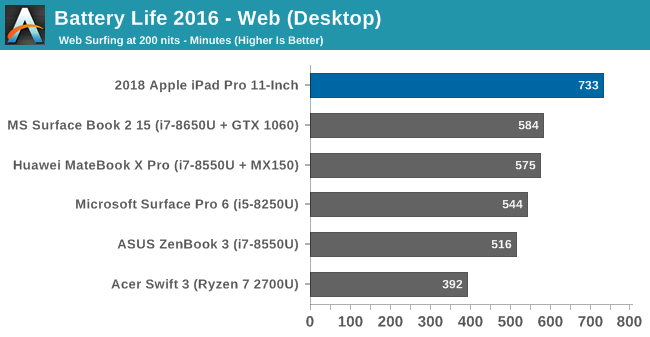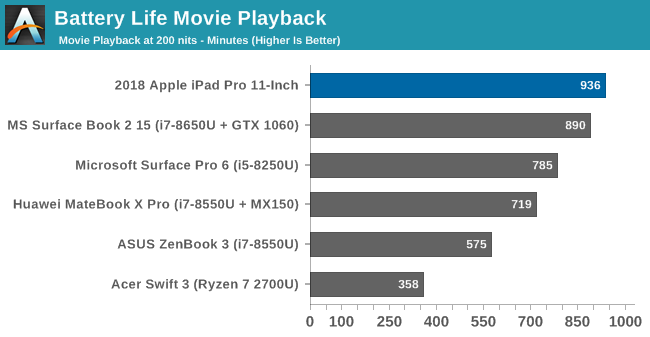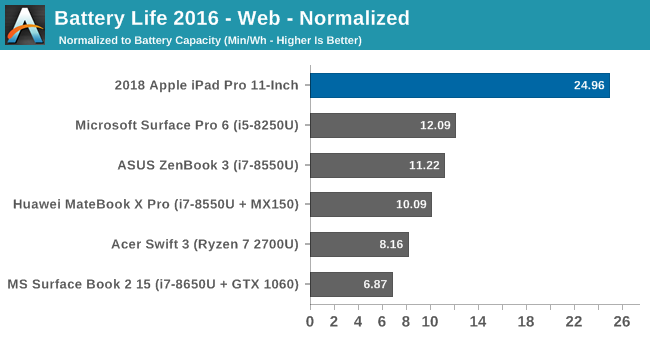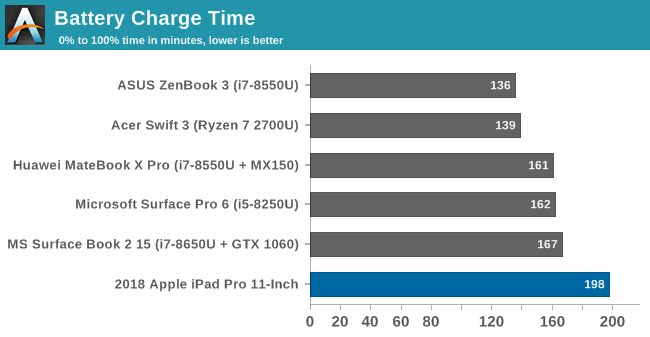The 2018 Apple iPad Pro (11-Inch) Review: Doubling Down On Performance
by Brett Howse & Andrei Frumusanu on December 4, 2018 10:00 AM ESTBattery Life
Apple is generally quite conservative when quoting battery life, and the iPad Pro 11 and 12.9 both are rated at up to 10 hours of web usage. The smaller model offers a 29.37 Wh battery, and the larger model offers 36.71 Wh of capacity. Both of these capacities are much lower than a Surface Pro 6, which has 45 Wh, or a typical Ultrabook, which would be well over 50 Wh.
Our battery tests are performed at 200 nits of brightness.
Web Browsing Battery Life


Our iPad achieved well over the rated ten hours, coming in at 12:13 on our web rundown test. This is a couple of hours longer than you’d get on an iPhone XS Max, and well ahead of the battery life on a Surface Pro 6 on this same test. This is one area where the efficiencies of the SoC, coupled with the operating system, pay big dividends compared to the PC space.
Battery Life Movie Playback

Movie playback is a unique situation where the workload can be offloaded to fixed function hardware in the media block, which is much more efficient than doing the work on the CPU. The iPad Pro achieved just over 15.5 hours of movie playback of a locally stored video. This is a couple of hours longer than you’d get on a Surface Pro with the same workload, despite the much smaller battery capacity.
Normalized Results

One thing we do on our PC reviews is to look at the efficiency of the device by removing the battery capacity from the equation. This shows the current gap between tablets and PCs. The Surface Pro 6 is one of our most efficient devices around, offering over 12 minutes per Wh of battery capacity, and the iPad over doubles that efficiency at almost 25 minutes per Wh. Or put in other terms, the iPad, on average, was drawing 2.4 Watts of power during the web test, and the Surface Pro 6 was drawing about 5 Watts. Considering much of the Surface Pro draw is the display, it shows you how effective Apple has been in driving down all of the power drain.
Charge Time
The other end of the spectrum is the charge time. Apple ships the iPad Pro with a USB-C power adapter with 18 Watts of output. That is quite a bit lower than you’d see on a laptop, and for example the MacBook ships with a 30 Watt AC Adapter. That means that the iPad charge time is quite long, despite the small battery capacity.

In addition, Apple ships an almost comically short USB-C cable with the iPad Pro. At three feet long, it will almost certainly be impossible to charge and use the iPad unless you happen to have an outlet right on your desk. At least with the move to USB-C getting a longer cable is not an issue, but for such an expensive device, this is a bit silly.










145 Comments
View All Comments
Hyper72 - Tuesday, December 4, 2018 - link
There are definitely lots of use cases where it can't beat laptops but saying it's just a large iPhone is disingenuous at best. It's all about use cases and what the individual person needs.MonkeyPaw - Tuesday, December 4, 2018 - link
I think we may find out soon enough if/when Apple migrates to its own SOCs for MacOS hardware.tipoo - Tuesday, December 4, 2018 - link
Can't wait.Look what it trounces with barely any cooling. Now give it a less constraining OS and heatpipes and fans and let's see what it can do.
Spunjji - Wednesday, December 5, 2018 - link
I disagree with you only in that I don't think Apple will ever want to add fans to this. Heatpipes, perhaps, but even then they've been tending on a "slimmer and lighter is better" trajectory for a long time. I imagine the first MacBook to run from a descendant of this SoC will be fanless and trumpeted as the lightest ever, silent, no dust issues, etc.tipoo - Monday, December 10, 2018 - link
Macbook and Macbook air, sure, go for it, but I hope the Pros retain active cooling, no matter how efficient the chip it still allows higher performance, plus with how GPUs scale with wattage for the 15". I hope they retain the 35W+35W chip setup and that should still mean fans.ChrisH362 - Tuesday, December 4, 2018 - link
In the article you mentioned “A more telling test, perhaps, will be once Adobe has ported over the full-fat version of Photoshop to the iPad, which is expected next year.” Instead of waiting on Adobe why not use Affinity Photo from Serif to perform some benchmark tests? The have working versions for Mac, Windows, and IPad. Their application works just as well, if not better in some areas as Adobe. https://affinity.serif.com/en-us/MonkeyPaw - Tuesday, December 4, 2018 - link
Affinity runs far better on my 2017 iPad Pro than my 2017 5K iMac. I can develop RAW on each, and the sliders are near instantaneous on iPad, but seriously slow on MacOS. Side by side, you’d swear two different developers made these apps, despite looking very similar.tipoo - Tuesday, December 4, 2018 - link
Sounds like a port thing, as this article demonstrates when going the other way things aren't perfect either. Affinity is mobile first.thunng8 - Tuesday, December 4, 2018 - link
That's incorrect Affinity photo was developed for mac and windows before the ipadSpunjji - Wednesday, December 5, 2018 - link
Which GPU does your iMac have? It's worth knowing as this may primarily be a function of performance scaling. You're asking the iMac to render 4x as many pixels as the iPad, and depending on your GPU it may be much less efficient than the iPad at moving that much information through its memory.Not arguing that performance is impressive here, just that the iMac may not be doing as badly as all that in comparison.